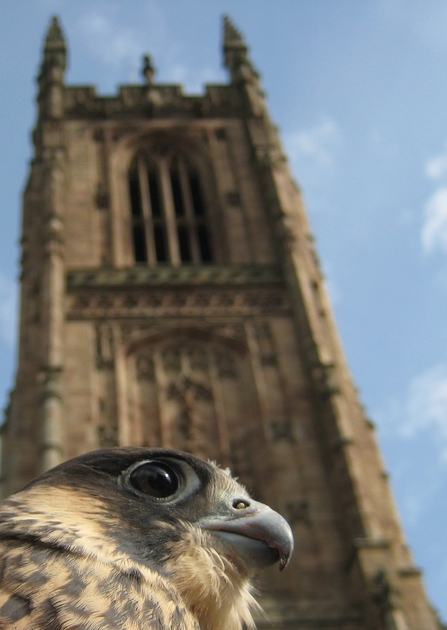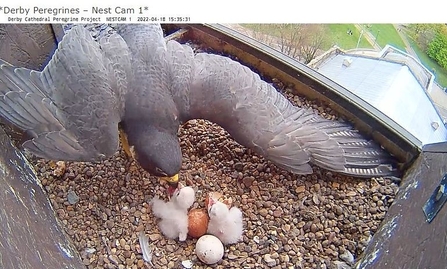
Urban Raptors: Peregrine Falcons Soar Through the Derby City Skies
© Bertie Gregory/2020VISION

Speed and Hunting Techniques
Peregrine falcons (Falco peregrinus) are renowned for their astonishing speed. Reaching up to 200 miles per hour in their hunting dive (stoop), they are the fastest birds in the world. This remarkable speed enables them to dive and strike prey with incredible precision. If their initial strike is unsuccessful, peregrines relentlessly chase their prey with agility and speed. In Derby, they have even been known to catch occasional owls or bats to supplement their daytime diets.
Urban Migration and Nesting
Originally nesting on natural cliff ledges, peregrine falcons have remarkably adapted to urban environments. Tall buildings, bridges, and power stations now serve as suitable nesting sites, providing the height and vantage points reminiscent of their natural habitats. The abundance of prey in cities, such as pigeons and starlings, and the extended visibility offered by city lights support their thriving populations in these new environments.
Conservation and Urban Success
In the mid-20th century, peregrine populations significantly declined due to pesticide use and habitat loss. However, concerted conservation efforts, including banning harmful chemicals and establishing breeding programs, have led to a remarkable recovery. By the 1990s, peregrines began repopulating urban areas, demonstrating their adaptability. As of 2014, the UK hosted approximately 1,769 breeding pairs (BTO Report 2014), many of which successfully nest in urban and coastal areas.

Peregrine falcon chicks - webcam screengrab by HelenSara
The Derby Cathedral Peregrine Project
The Derby Cathedral Peregrine Project is a shining example of successful community engagement and conservation. In 2006, raptor enthusiasts observed peregrines attempting to nest at Derby Cathedral. A wooden ledge was designed and installed to support their nesting efforts, resulting in a thriving site for the peregrines. The project has generated widespread interest by installing webcams, which provide live footage of the birds' activities, allowing people worldwide to follow their nesting and breeding cycles. To date, fifty-eight chicks have successfully fledged from Derby Cathedral's nesting platform, a testament to the project's success.
Educational Outreach and Community Involvement
Derbyshire Wildlife Trust enhances community engagement through educational assemblies in schools across Derbyshire. These assemblies aim to educate students about peregrine falcons, their behaviour, and the importance of conservation efforts. The Trust fosters a deeper connection and sense of responsibility toward environmental stewardship by involving young people in wildlife education.
Critical breeding months are typically from March to early July. When the chicks are hatched and preparing to fledge in May and June, Derbyshire Wildlife Trust co-organises Watch Point Events on Cathedral Green in collaboration with Derby Cathedral and partners.
These events allow visitors to observe peregrine chicks up close using telescopes, providing a unique and interactive educational experience. The combined efforts of the Cathedral and the Trust ensure a well-coordinated and engaging experience for the public, helping to raise awareness and support for peregrine conservation.
Join the Action
Click the links below to join the peregrines and follow their progress on the webcam, as well as via the official blog, which provides the latest news.
Derby Peregrines Blog
The Derby Peregrine Project is a partnership between Derby Cathedral, Derbyshire Wildlife Trust, The Cathedral Quarter, and Derby City Council’s IT team.
Visit Derbyshire Wildlife Trust's website to learn how it manages and supports the Derby Cathedral Peregrine Project.

